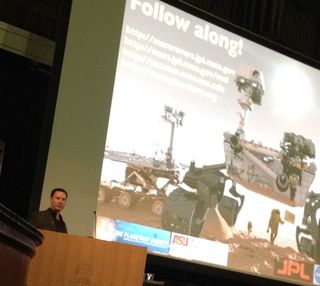10 Years of Mars Exploration: Red Planet 'Postcards' Tell Rovers' Tale

TORONTO — Water. Blueberries. Lakes. Mountains. As Jim Bell described huge picture "postcards" late last month here at the Toronto Science Festival, for a moment it looked like highlights from a summer vacation.
The pictures, though, were alien vistas seen through the eyes of NASA's Curiosity, Spirit and Opportunity rovers on Mars. Bell is an astronomer and planetary scientist at Arizona State University who specializes in rover imaging systems. This makes him one of the few interplanetary photographers in the world, despite having his feet firmly planted on Earth.
"I've been spending most of the last 10 years of my life on Mars, living there vicariously through the eyes of some interesting robots," Bell said during his presentation on Sept. 28. [The 7 Biggest Mysteries of Mars]
"It's an inhospitable environment to live in, as we know it," he added. "You would need to bring oxygen. You would need to bring a spacesuit. Mars would try to kill you in so many different ways, if you go there, and it would probably succeed."
Searching for an 'amazing biologic signal'
Although Bell's pictures were originally taken for scientific use, some of them transcended that original purpose, he said. He flashed a picture of the Opportunity rover casting a long shadow late in the Martian day, or sol.
"This is Opportunity pretending she's a monster truck," he said, eliciting a laugh from the audience of several hundred people.
Get the Space.com Newsletter
Breaking space news, the latest updates on rocket launches, skywatching events and more!
Bell is the lead scientist for the Pancam color imaging system on the Mars Exploration Rovers (Spirit and Opportunity) and co-investigator for Curiosity's workhorse Mastcam camera.
Through the eyes of these sentinels, he's seen plenty of evidence of past water on Mars: rocks carried by ancient creeks, small hematite "blueberries," and plenty of "squiggly line science" (or spectroscopy) showing minerals created in ancient water. Signs of Martian life itself, though, remain elusive.
"We haven't found any Martian organic molecules, but we have for the first time the capability to make that measurement," Bell said. "Was Mars inhabitable? Maybe it's unlikely we find some amazing biologic signal, but maybe it will happen. Who knows? It's exciting to think that we do that every day."
Incredible longevity

Bell made repeated references to the longevity of the Mars Exploration Rovers. Spirit lasted six Earth years after its landing in January 2004, and Opportunity will mark a decade of Red Planet operations in January 2014. Each rover's mission was originally designed to last just 90 days.
He flashed a picture of Spirit's view shortly after landing in January 2004. "We saw these mountains and said, 'They're pretty, but oh well, too bad, we'll never get there.' We never imagined we'd be cresting this one and going to the other side."
Opportunity is still in reasonably good health, with Bell citing only its dusty solar panels as a potential near-term threat to its mission. Meanwhile, the car-size Curiosity rover, which landed in August 2012, is about 60 per cent into its two-year prime mission on Mars, he said.
NASA's next rover to Mars is expected to leave Earth in 2020. Bell called the yet-unnamed machine a "Curiosity clone," but with different instruments on board that could include the capability to collect samples for eventual return to Earth.
Follow Elizabeth Howell @howellspace, or SPACE.com @Spacedotcom. We're also on Facebook and Google+. Originally published on SPACE.com.
Join our Space Forums to keep talking space on the latest missions, night sky and more! And if you have a news tip, correction or comment, let us know at: community@space.com.

Elizabeth Howell (she/her), Ph.D., is a staff writer in the spaceflight channel since 2022 covering diversity, education and gaming as well. She was contributing writer for Space.com for 10 years before joining full-time. Elizabeth's reporting includes multiple exclusives with the White House and Office of the Vice-President of the United States, an exclusive conversation with aspiring space tourist (and NSYNC bassist) Lance Bass, speaking several times with the International Space Station, witnessing five human spaceflight launches on two continents, flying parabolic, working inside a spacesuit, and participating in a simulated Mars mission. Her latest book, "Why Am I Taller?", is co-written with astronaut Dave Williams. Elizabeth holds a Ph.D. and M.Sc. in Space Studies from the University of North Dakota, a Bachelor of Journalism from Canada's Carleton University and a Bachelor of History from Canada's Athabasca University. Elizabeth is also a post-secondary instructor in communications and science at several institutions since 2015; her experience includes developing and teaching an astronomy course at Canada's Algonquin College (with Indigenous content as well) to more than 1,000 students since 2020. Elizabeth first got interested in space after watching the movie Apollo 13 in 1996, and still wants to be an astronaut someday. Mastodon: https://qoto.org/@howellspace
